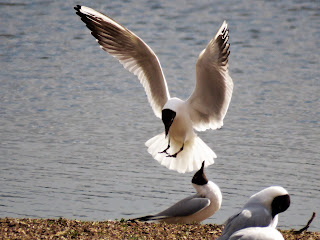Now in full breeding plumage drake Tufted Ducks are ‘black and white’ with exaggerated tufts.
A trio of Tufties here with two drakes vying for the attention of the duck. He looks a bit of a spiv to me! Note the sex-difference in eye colour.
Caught in mid-jump the duck is about to dive for food – these ducks eat plant material not fish.
Two battling Coots once again demonstrate their ability to walk on water.
One of the local Pheasants in stunning plumage well lit by the sun.
An adult Black-headed Gull flying by on a mission.
And the underside of an adult in breeding plumage.
And another.
A pair go a-chasing.
Another hovering bird making its presence known.
And about to touch down. I assume that what sound like a cacophony of calls to us enables individual birds to recognise each other.
I'm not sure whether this calling bird is being greeted or told there is ‘no room at the inn’.
Even on the deck all is not calm.
So they have webbed feet then.
Two birds inbound to land. Strange serration effect on the spread primaries of the leading bird.
The primaries are well-spread on this bird too.
Perhaps making overtures to one of the Black-heads?
This shot shows the difference in head pattern, head colour – the Med Gull is solid black – and the stouter redder bill.
The bill shown well here as is the complete lack of black in the body and wing feathers.
The neck patch changes colour with the angle of the light
One of the specialties – a fine Tree Sparrow. There are up to 30 of these birds in a small colony here.
The harmless Bee-fly (Bombilius major). It uses its proboscis to such nectar from deep in flowers.
Here we see the hoverfly Eristalis tenax or Common Drone-fly.
And a plan view of the same individual.
The markings are variable on this species – here is a different specimen. “drone-fly” because they resemble the drones (males) of hive bees. The short antenna separate hoverflies from true bees.
Another plant I am struggling to ID. The leaves suggest a deadnettle and perhaps Hen-bit Deadnettle. However that has pink flowers. The most common blue flowers in the same ‘Mint’ family are Bugle but the leaves are all wrong and the blue flowers lack the darker throat shown here. I could always lapse back to the ‘garden escape’ catch-all!
(Ed Wilson)






























